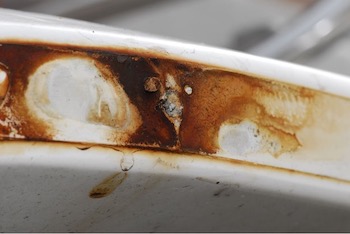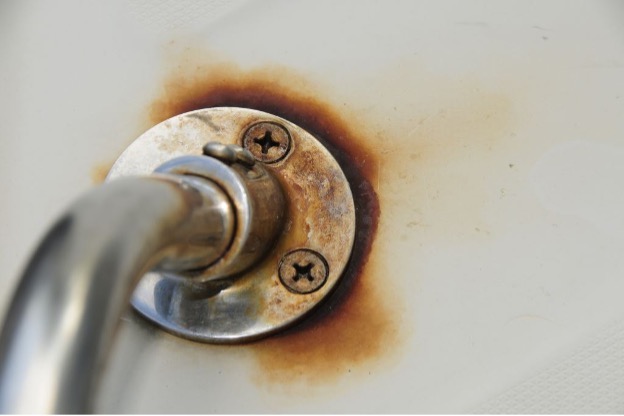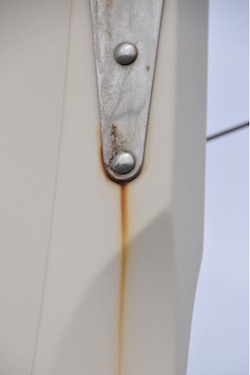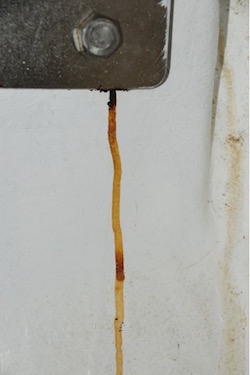Preventing Rust Stains on and Around Stainless-Steel Hardware
Rust stains running across a deck or hull are nothing new. While unsightly, in many cases they are simply ignored or begrudgingly accepted as part of modern boat ownership. In some cases, however, that rust can be a message, and it’s not a very good one. If the staining is occurring adjacent to stainless steel hardware, then the “rust” is often the byproduct of a process known as crevice corrosion, whereby normally passive, corrosion-resistant stainless steel becomes active (see SDMC Marine Systems Excellence Miracle Metal). “Active” for stainless steel is analogous to rusting for ordinary mild steel. In both cases, the metal is compromised, although in the case of stainless steel it’s much more insidious as the flaking and shale associated with conventional steel is not present. Thus, whether it’s for cosmetic or structural reasons, preventing this staining is well worth the effort.
To prevent staining, sometimes referred to as “tea staining”, of this sort it’s important to understand the process by which it occurs. In order for stainless steel to remain rust-free, it must be continuously exposed to a source of oxygen. In doing so, stainless steel is able to replenish and maintain the tough oxide layer that allows it to resist rusting. Stainless steel used on deck is exposed to air, which certainly provides ample oxygen to maintain the oxide layer. Even stainless steel used below the waterline provided the water moves freely and regularly, may be exposed to enough oxygen to remain passive. If, however, the stainless steel is exposed to an oxygen-poor environment, stagnant water for instance, then it’s likely to enter an active state.

In order to remain rust-free, stainless steel must have continuous access to oxygen, however, water trapped beneath a flange like this quickly becomes stagnant and oxygen depleted, which in turn leads to corrosion and staining.
Where deck and above the waterline hull fittings are concerned, brown staining is usually a result of the use of low corrosion resistance, i.e. 304 or 18-8 stainless alloy and/or exposure to stagnant water. This alloy, by the way, is what’s used for 99% of all common fasteners, bolts, screws and nuts. In the first case, short of replacing the hardware there’s not much that can be done. In the latter case, however, there is a solution. If you look closely, what’s often clear about the staining is that it emanates from the perimeter of, or under, the offending hardware. This is because water becomes trapped beneath the hardware, where it becomes stagnant and thus oxygen-depleted, where it then leads to “activation” of the stainless steel; it begins to corrode. This phenomenon extends to fasteners as well, if the holes through which they pass in decks, cabins and hulls, are filled with stagnant water they will become active.
The solution for this problem involves removal, thorough cleaning, de-waxing, and fully bedding the hardware (see SDMC MSE Caulk and Sealant). That is, instead of applying bedding compound only to the areas where fasteners pass through, the entire base of the hardware, be it a cleat, port light trim ring, grab rail flange, chock or any other hardware, should be liberally bedded with sealant that will both create a watertight seal and exclude water that could migrate beneath the hardware base. Exclusion of the water is the key to preventing staining.

In addition to bedding, polishing otherwise rough or irregular stainless steel will minimize surface staining (polishing removes micro-pits where corrosion gets its start). Avoiding water traps in recesses where (often undersized) fasteners are installed will also aid in prevention of crevice corrosion and staining. Fastener heads should fill the hole and countersink in any hardware, always use the largest screw that will fit, and it should be fully bedded. Even then, fastener recesses can form water traps which lead to staining. Using 316 stainless alloy fasteners, as well as polishing fastener heads, will reduce the incidence of staining.
By Steve D’Antonio
Beginning his career in 1988, as a marine mechanic, electrician, manager and partner of a custom boat building shop and two boatyards and technical journalist, as well as through Steve D'Antonio Marine Consulting, Inc, Steve provides personalized and hands-on service to boat buyers, boat owners, boat builders and equipment manufacturers, as well as others in the marine industry around the world. Steve is an American Boat and Yacht Council Certified Diesel, Electrical, Corrosion and Systems Master Technician/Adviser. To learn more or to contact Steve, go to SteveMarineConsulting.com.


